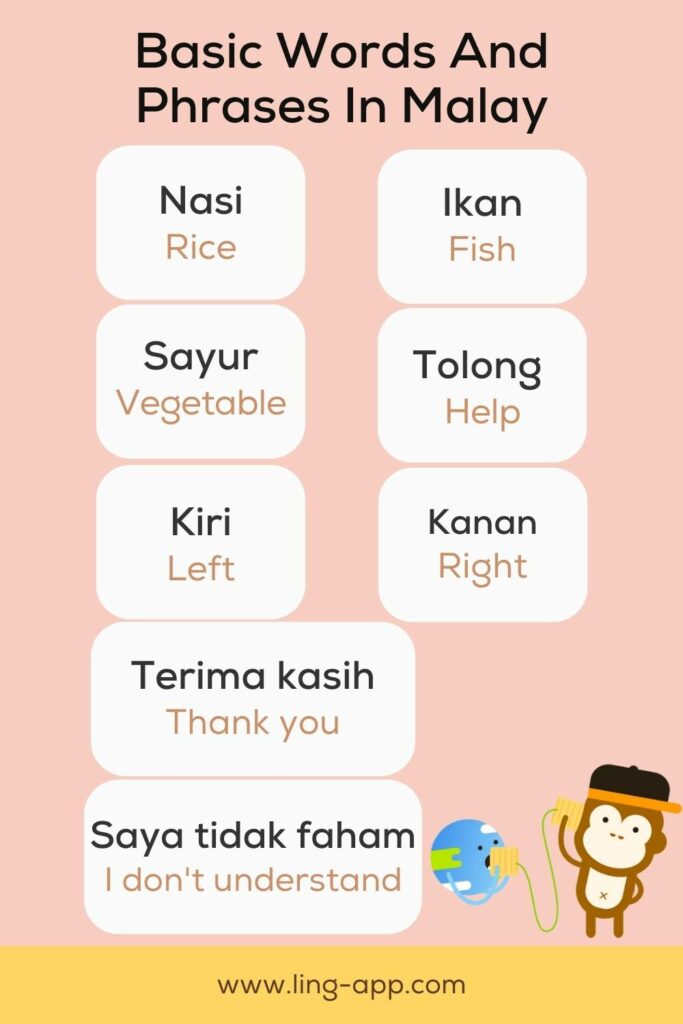Malaysia is a beautiful country known for its tropical climate, diverse culture, and delicious food. But suppose you’re planning a trip there or doing business with Malaysians. In that case, it’s important to note that Malay (also known as Bahasa Malaysia or Bahasa Melayu) is the official language spoken by most of the population. By learning basic words and phrases in Malay, you’ll be able to find your way around the country, make small talk with locals, and understand the culture more. This article will give you the best guide to basic Malay words and phrases that will help you connect with locals and understand their speaking culture. Let’s start!
The Malaysian Culture And Its Relation To The Language
The Malay language is an essential aspect of Malaysian culture. It is used in traditional ceremonies, religious practices, and everyday communication. So, understanding the language can help you appreciate and understand the culture more.
It’s worth noting that the culture of Malaysia is a melting pot of various ethnic groups, such as Malay, Chinese, and Indian. This makes it a unique and diverse country. Therefore, learning Malay allows you to understand and appreciate the customs and traditions of each group and how they have influenced the culture.
The Role Of The Language In Connecting With Locals
By learning basic words and phrases in Malay, you’ll be able to safely explore the country, make small talk with locals, and be one of them. This can be particularly useful when traveling to a new place or communicating with people from different cultures.
Additionally, speaking Bahasa Malaysia can help break down barriers and open doors to new opportunities and experiences. By showing an interest in the language and culture, locals are more likely to open up and share their customs and traditions with you, which can be an enriching experience.
Finally, speaking Malay can help establish trust and build stronger personal and professional relationships with locals. All these will not only make your travel enjoyable but also successful.
Malay Phrases In Real-Life Situations
Learning essential Malay phrases can be particularly useful in everyday situations, such as ordering Malay food, asking for directions, and making friends. Here are a few examples of everyday situations where knowledge of basic Malay words and phrases can be helpful:
Ordering Food At A Local Restaurant
| English | Malay |
| Rice | Nasi |
| Chicken | Ayam |
| Fish | Ikan |
| Vegetable | Sayur |
| Spicy | Pedas |
| Not spicy | Tidak pedas |
| A little | Sedikit |
| A lot | Banyak |
| Yes | Ya |
| No | Tidak |
Asking For Directions
| English | Malay |
| Where? | Di mana |
| Left | Kiri |
| Right | Kanan |
| Street | Jalan |
| I am lost | Saya tersesat |
| Help | Tolong |
Making Small Talk With Locals
| English | Malay |
| How are you? | Apa khabar |
| How about you? | Bagaimana dengan anda |
| My name is | Nama saya |
| Can you help me? | Bolehkah anda membantu saya |
| Thank you | Terima kasih |
| I’m fine too | Khabar baik juga |
Basic Malay Greetings And Phrases
| English | Malay |
| Selamat pagi | Good morning |
| Selamat tinggal | Goodbye |
| Apa khabar | How are you? |
| Selamat malam | Good night |
| Bagaimana dengan anda | How about you? |
| Nama saya | My name is |
| Bolehkah anda membantu saya | Can you help me? |
| Terima kasih | Thank you |
| Khabar baik juga | I’m fine too |
| Saya tidak | I don’t or I don’t have |
| Selamat petang | Good afternoon |
| Selamat tengah hari | Good noon |
| Selamat jalan | Safe journey |
| Sama sama | You’re welcome |
| Saya tidak faham | I don’t understand |

Common Mistakes When Speaking Malay
Learning a new language can be challenging, and it’s easy to make errors when speaking Malay. Here are some of the most typical mistakes that Malay learners make:
Pronunciation
Malay has several vowel sounds that are not found in English, such as the “a” sound in “kaki” (foot) and the “e” sound in “kedai” (shop). Also, it has several diphthongs or combinations of vowel sounds.
This can be challenging for some English speakers to pronounce correctly, such as the “ai” sound in “makan” (eat) and the “au” sound in “kau” (you). To avoid these mistakes, it’s important to listen to Malay people, pay attention to the stress on certain syllables, and practice regularly with the Ling app.
Tips For Pronunciation
One of the most challenging things when learning Malay or another new language is getting the pronunciation and writing right. Here are a few tips and resources to help you:
- Listen to native speakers and try to imitate their accents.
- Pay attention to the stress on certain syllables and the intonation of phrases.
- Practice with online resources and apps such as the Ling app.
- Watch Malay language videos and try to repeat the words and phrases spoken.
- Take a class or find a language partner to practice speaking with.
- Try to immerse yourself in the language as much as possible by listening to music, watching TV shows or movies in Malay, and reading books and articles.
Word Order
In Malay, the word order is subject-verb-object (SVO) as opposed to subject-object-verb (SOV) in English. For example, “Saya makan nasi” (I eat rice) – The word order is “subject-verb-object” (SVO) in this sentence. “Saya” (I) is the subject, “makan” (eat) is the verb, and “nasi” (rice) is the object.
Verb Tense
Malay has several different verb tenses, such as the present, past, and future tenses, and it’s important to use the correct one when speaking. This is because the verb forms in Malay often differ from those in English. For example:
- Present Tense: “Saya makan” (I eat)
- Past Tense: “Saya makan tadi” (I ate earlier)
- Future Tense: “Saya akan makan” (I will eat)
Noun Classifiers
In Malay, certain nouns are preceded by classifiers, which indicate the noun’s grammatical function. For example:
- “Buku” (book) + classifier “sebuah” (a) = “Saya membaca sebuah buku” (I am reading a book).
- “Meja” (table) + classifier “sebuah” = “Dia duduk di sebuah meja” (He sits at a table).
- “Kucing” (cat) + classifier “seorang” (a) = “Dia punya seorang kucing” (He has a cat).
Politeness Levels
Malay has different levels of politeness, depending on the relationship between the speaker and the individual being spoken to. For example:
- Formal: In formal situations, such as speaking to someone more senior or in a position of authority, it’s important to use formal language and address them with titles such as “Encik” (Mr.) or “Puan” (Ms.).
- “Encik, boleh saya bertanya sesuatu?” (Mr., may I ask you something?)
- Informal: In informal situations, such as speaking to friends or family, it’s appropriate to use less formal language and address them by their first names.
- “Apa khabar, Ahmad?” (What’s up, Ahmad?)
- Polite: In Malay, it’s common to use polite forms of address, such as “sudah” (already) or “belum” (not yet), in conversations.
- “Sudah makan?” (Have you eaten?) or “Belum, saya akan makan sekarang” (Not yet, I will eat now)
To avoid this mistake, it’s vital to be aware of the different levels of politeness in Malay and to pay attention to the social context in which you speak.

Master The Malay Language Effortlessly With Ling App
If you want to learn the basic words and phrases in Malay, you’re in the right place. Not only is it a unique and fascinating language rich in culture and history, but mastering it can open new doors and opportunities for you. Whether you’re planning to travel to Malaysia or expand your language skills for professional growth, the Malay language is worth learning.
But let’s be honest! Learning a new language may be tricky. That’s why I recommend using the Ling app; it makes learning fun and engaging! With our in-depth guides and lessons, you’ll be able to master the Malay language in no time.
Download the Ling app from the App Store or Google Play today and take the first step towards mastering the Malay language.



































































